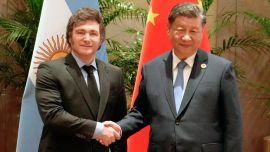Today is April Fool’s Day (the Anglo-Saxon world’s equivalent of el Día de los Inocentes on December 28), a tradition dating back to times when fake news was not taken so seriously as today but was permitted solely on that day and transmitted in a spirit of tongue-in-cheek leg-pulling (if that anatomically mixed metaphor may be excused). It was the year before my entry into the Buenos Aires Herald newsroom but I was told that for the April Fool’s Day of 1982 some of my colleagues toyed with the idea of announcing an Argentine invasion of the Malvinas although refraining – only for truth to be stranger than fiction the next day.
Anyway the topic of today’s column is convertibility, since for reasons best known to himself Domingo Cavallo (who might have known better with his Harvard education) chose April Fool’s Day to launch peso-dollar parity back in 1991 – a proposal which would seem even more like leg-pulling nowadays. The typical April Fool hoax is either immediately met with complete disbelief or (if swallowed) the deceived recipients are quickly reminded of their innocent ingenuity (“April Fool, you!”). But convertibility would prove to be perhaps the longest April Fool ever, lasting 3,934 days until early 2002.
Yet it would be unfair to dismiss convertibility as an April Fool hoax (quite apart from the fact that it can be dated back to its approval by Congress on March 27, 1991). Although demonised throughout this century on the back of its disastrous end (much like the Mauricio Macri Presidency in more recent years) with the 2001-2002 meltdown, convertibility also brought some good times – four straight years of rapid growth, as well as doing the trick in bringing inflation down from 3,079 percent in 1989 to three percent in 1992 (the same annual figure surrealistically forecast for next month early this year by Economy Minister Sergio Massa). Even the best years have been criticised for taking unemployment up from seven percent to 17.5 percent in 1995 but this was the price of productivity gains from structural reforms rather than convertibility as such. Dollar-peso parity was hamstrung by fiscal indiscipline with the deficit averaging four percent of gross domestic product during the 1989-1999 Carlos Menem presidency – convertibility also had the misfortune of co-existing with the balanced budgets of Bill Clinton (with fiscal surpluses in his last four years) when ‘Reaganomics’ or the United States fiscal deficits of this decade might have been better company. But convertibility was ultimately doomed by being inextricably linked to a world currency and hence vulnerable to international turbulence – Mexico’s tequila crisis of 1995, Russia in 1997-1998 and the Brazilian maxi-devaluation of 1999 proved fatal.
Annual inflation might now be three digits and not four as in 1989 and 1990 but the yearning for something akin to convertibility is just as strong today. The highly fashionable libertarian economist Javier Milei has proposed simple dollarisation (sustained by Ecuador for almost quarter of a century) without convincing most of his colleagues how you can dollarise without dollars – he has proposed swapping off government bonds against Leliqs but do two wrongs make a right? Even with President Alberto Fernández cosying up to his US host Joe Biden in the White House last Wednesday, the government does not contemplate going down that road, especially after demonising convertibility nineteen to the dozen for so long – instead, buoyed by Lula’s return to the presidency, they have floated monetary unification with Brazil. While rubbished as “a horrible plan” even by such a friendly economist as the 2008 Nobel Prize winner Paul Krugman (no accident that his surname begins with a K), the proposal has been bizarrely applauded by the hawkish opposition deputy Fernando Iglesias, who finds merit in binding Argentina to the macro-economic stability of a larger but symmetrical commodity-based economy like Brazil. But the euro experience has also shown that monetary unification entails long years of harmonising macroeconomic coordinators.
Instead of long years the government has a few frantic months as it attempts to coast through to the August primaries, the October elections and the inauguration of a new president in December – only if it fails to keep afloat and hyperinflation runs riot can any drastic currency reform be expected. Since any new government may have to hit the ground running after taking office on December 10, we should not rule out the 21st century version of a convertibility plan launched on an April Fool’s Day starting life on December 28 – Día de los Inocentes.


















Comments